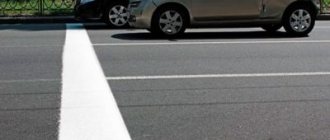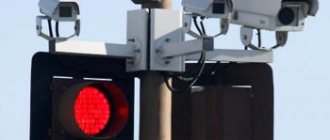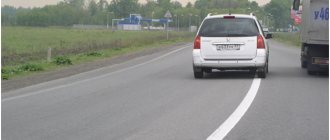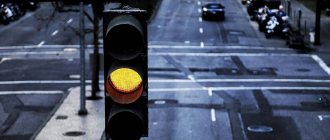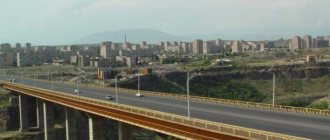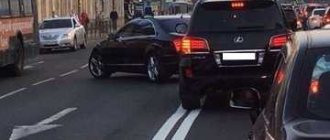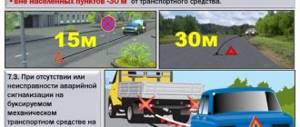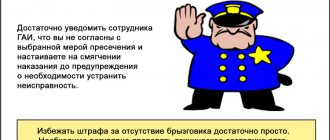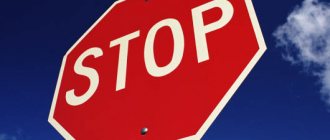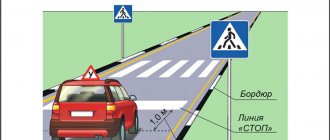What does the stop line mean - read the traffic rules
First, let's figure out what the stop line is for. Firstly, its presence signals to drivers the need to stop to let pedestrians cross the road along the so-called zebra crossing. Secondly, this marking occurs at intersections provided with traffic lights. There it is needed in order to protect a driver stopped at a red light from a possible collision with a car moving along a perpendicular road.
A stop line at an intersection is also needed to ensure that vehicles do not interfere with each other when performing any maneuver according to traffic regulations, for example, a U-turn. For an experienced driver, a U-turn will seem like a trifle, but a beginner may not “fit” into the dimensions of the intersection and, when maneuvering, may go beyond its boundaries. If cars on a perpendicular road are parked too close to the border of the intersection, driving beyond the stop line, the chances of an accident will rapidly increase.
It is worth noting that a stop line can be either a marking or a road sign . Don't confuse them. If there is a “Stop” sign at the intersection, the driver must stop the car near the sign in two cases: when the red light is on or the traffic controller gives a prohibitory signal. The same situation applies to the corresponding markup. But the combination of the line and the “STOP” sign on a red background obliges the driver to stop in any case. It hardly needs to be said that ignoring such important signs can cost you not only and not so much the drawing up of a protocol, but your health and even your life.
Where to stop at an intersection with and without a stop line and what the violation will be
Everyone knows that the stop line indicates where the car stops before the intersection: we have already found out what the punishment is for crossing it and whether it is possible to avoid a fine by backing up. However, in the absence of a stop line, many drivers ignore or do not remember the rules, believing that they can stop anywhere. Let's remember where to stop at intersections, what to consider when stopping, and what punishment you can get for violating the rules.
Where should you stop at an intersection with a stop line?
We have already answered this elementary question: you need to stop at such intersections in front of the stop line. However, there is one more condition that needs to be remembered: sign 6.16 “Stop Line”. It duplicates the stop line and indicates the stopping place when there is a prohibitory traffic light. That is, the absence of a stop line in itself in the presence of sign 6.16 does not change anything: stopping after the sign carries the same penalty as for crossing the stop line. The only difference between the stop line is that it can be combined not only with sign 6.16, but also with the “Stop” sign, also indicating the stopping place.
Where should you stop at an intersection without a stop line?
Now let’s move on to a more “complicated” case: stopping in front of an intersection in the absence of a stop line and sign 6.16. In fact, everything here is also simple: like the previous case, this situation is regulated by clause 6.13 of the traffic rules. It states that in the absence of a stop line, the driver must stop in front of the intersecting roadway without interfering with pedestrians.
Considering that, according to the traffic rules, an intersection is considered to be the direct intersection of roadways, the driver is actually required not to enter the intersection itself when the light is red. In addition, you need to remember about pedestrians: stopping at a pedestrian crossing is prohibited, so if there is a zebra crossing, you need to stop in front of it. And one more thing: despite the fact that the exit from the adjacent territory onto the road according to the traffic rules is not an intersection, the rules still establish the requirement to let pedestrians pass when exiting and entering.
The only nuance indicated in the same paragraph 6.13 is compliance with paragraph 13.7 of the traffic rules, which we also examined. This paragraph applies to drivers turning left at intersections and indicates that if there are stop lines at the intersection in front of the traffic lights, then you must comply with the requirements of each traffic light - that is, after turning left on a green light, stop again and wait for the next green signal.
In addition, you need to remember that stopping correctly at an intersection does not guarantee the absence of a fine: you also need to not rush to start moving. We have already found out that starting at a red-yellow traffic light is equivalent to driving through a red light, so it would be a shame to get a fine after stopping correctly before an intersection.
What is the penalty for stopping incorrectly at an intersection?
The penalty for stopping illegally at an intersection varies depending on the type of intersection. At controlled intersections with a stop line, driving beyond the line or sign 6.16 is punishable under Part 2 of Article 12.12 with a fine of 800 rubles. If the intersection is unregulated, but there is a stop line along with a “Stop” sign, then crossing the stop line is a failure to comply with the requirements of the road sign, which, according to Part 1 of Article 12.16, is punishable by a warning or a fine of 500 rubles (and if a camera is installed at the intersection , then she will issue a fine in any case). If there is no stop line and sign 6.16, and the driver passed the traffic light and stopped with full or partial access to the intersection, then this will be interpreted as driving through a red light: part 1 of article 12.12 of the Code of Administrative Offenses provides for a fine of 1000 rubles, and a repeated violation in accordance with part 3 of the same article means a fine of 5,000 or deprivation of rights for 4-6 months.
Source
Amount of the fine - what will the violation cost?
The fine for a stop line in 2013–2014 is quite a significant amount - around 800 rubles. But its size varies depending on the situation. Thus, a fine for driving through a stop line, driving through it and driving beyond the stop line at a red traffic light, or for a prohibitory gesture by a traffic controller standing on the road, will cost the violator all of 800 rubles.
But if you crossed the stop line at an uncontrolled intersection (which is important!), then the fine will be 500 rubles. Be extremely careful: near the stop line or instead of it there may be a road sign 2.5 “Driving without stopping is prohibited”, we have already talked about it above. You must stop near it and then continue moving.
Sequence of traffic lights -
While learning to drive, you will encounter many traffic lights. The UK traffic light sequence described here is an important part of the driving training and theory test.
While understanding the light sequence is fairly simple, there are often big challenges when dealing with other road users and pedestrians at traffic lights. Of course, it is important to obey traffic signals, but it is equally important to be constantly aware of your surroundings.
Cyclists, and pedestrians in particular, can be unpredictable around busy light-controlled intersections.
This guide provides information about the traffic signal sequence of different systems on UK roads, as well as an explanation of traffic lights and the rules and laws that must be followed at traffic lights.
UK traffic light sequence explained
- Red traffic light The vehicle must stop just beyond the white stop line at the traffic light.
- Red and yellow traffic lights Also means a stop, but can prepare for a trip. The vehicle must not pass through the lights until the light turns green.
- Green traffic light When the light turns green, you can continue if the path is clear.
- Amber Traffic Light When one amber light comes on, you should prepare to stop just before the first white line. You can only go through amber if you have just crossed the stop line when it changes, or are too close to the stop line and stopping may cause an accident.
Traffic light filters
Traffic light filter
The green traffic light filter allows traffic to move in the direction of the arrow. A directional green filter arrow means you have priority over traffic as they will glow red when turning. As with all intersections, be aware of pedestrians and cyclists when turning. Just because you have priority, there is a chance that another car, cyclist or pedestrian crossing will be where they shouldn't be.
It is also relatively common for a learner driver to focus primarily on the red light and not notice that the green filter light turns on, allowing him to continue. During your driving test, if you do not recognize the green filter light for some time or the examiner even notifies you about the illuminated filter, it may cause your driving test to fail. The filter indicator may light up before or after the full green phase. Make sure you keep an eye on the filter light as well as the main phase lights.
Junction boxes
Traffic light filters can be located anywhere, including at intersections. Be aware if a yellow field transition is present. If the green filter is on, you can only continue if your exit is clear and you must not stop at the yellow field.
Traffic light filter rules
Below are the rules for turning a red car at an intersection where a filtered traffic light is directing traffic.
Green light filter with backlight
Green light filter with backlight
If you are turning right as shown in the diagram and the green filter traffic light is on, oncoming traffic will have a red light, which gives you priority to proceed. (Image may be enlarged)
Green filter light is off
Green filter light is off
If you are turning right and your green indicator light is not on or it is different, you can still proceed as long as the green indicator light is on full phase. However, you must yield to oncoming vehicles and wait at the turning point. (Image can be enlarged).
The traffic light turned red
The traffic light turned red
If you are waiting to turn right and the light turns red, make sure you exit the intersection by turning right when other oncoming traffic has passed. Never stay connected as you will stop the movement. (Image can be enlarged).
Intersections and turns - Traffic rules - Safety and rules - Roads
Approximately half of road accidents in NSW occur at intersections. It is important that you approach the intersection at a speed that allows you to give way to any vehicles approaching the intersection.
The information provided in this section is indicative only and is subject to change at any time without notice.
This information is also available in the Road User Handbook.
The full text of the NSW Road Rules can be found on the NSW Law website.
Getting caught in the middle of an intersection when the light changes. You should remain on the approach side of the intersection until you see a space in your lane on the other side of the intersection that is large enough for your vehicle.
Keep left
The cardinal rule of the road in New South Wales is keep to the left .
rules to give way where there are no signs
Some intersections do not have traffic lights or signs. As a general rule, if you are turning into the path of another vehicle, you must yield the right of way.
When turning at an intersection you must give way to:
- Oncoming cars are driving straight ahead.
- Oncoming cars turn left.
- Any vehicle on your right.
If you and an oncoming car are turning right at an intersection, both cars must pass in front of each other.
If other drivers do not yield to you, do not force them or yourself into a dangerous situation.
You must also give way to all pedestrians at the intersection or road you enter.
Stop signs and stop lines
STOP signs and STOP lines (a continuous line) are used at intersections to control traffic.
When you come to a STOP sign, you must come to a complete stop before reaching the STOP line and as close to the line as possible. Where there is no STOP line, stop before reaching and as close to the intersection as possible.
A STOP sign or STOP line means that you must yield the right of way to all vehicles entering, entering or approaching the intersection, regardless of whether they are turning left or right or going straight ahead.
You must give way to any pedestrians crossing the road you are turning onto.
Skipping a stop sign means the driver must remain stationary until it is safe to proceed.
Car A (blue) must give way to car B (green).
give way to signs and give way to lines
GIVE WAY signs and GIVE WAY lines (dashed lines) are used at intersections to control traffic. When you come to a GIVE WAY sign, you should slow down and prepare to stop if necessary.
A GIVE WAY sign or line means that you must give way to all vehicles entering, entering or approaching an intersection, whether they are turning left or right or going straight ahead. You must give way to any pedestrians crossing the road you are turning onto.
Yielding to a GIVE WAY sign means that the driver must reduce speed and, if necessary, stop to avoid a collision.
Car B (blue) must give way to car A (green).
If a STOP or GIVE WAY sign has been removed, the line marked across the road has the same meaning as the sign . You must stop or give way.
T intersections
At T intersections, a vehicle traveling on a terminal road must yield the right of way to all pedestrians crossing the road or vehicles traveling on the road that continues, unless otherwise indicated.
Car A must give way to car B
. This diagram shows the T intersection where the continuing road (which is marked with dashed white lines) goes around the corner. Car B must signal to leave the continuing road and enter the final road.
Car B must give way to car A
Signaling
You must indicate to let others know what you plan to do. Give plenty of warning by signaling before turning left or right or changing lanes.
Make sure your indicator turns off after every turn or lane change. If your indicators do not work, are difficult to see, or your vehicle does not have indicator lights, you should signal with your hand when making a right turn or stopping.
Signal to turn right Signal to stop or slow down
Turning
Plan your turns in advance so that you are on the right section of road and have enough time to indicate where you want to turn.
Left turn
You must make a left turn from the left side of the road. When turning:
- Signal left
- Drive closer to the left side of the road
- Keep to the left of the road you enter on
- Use the slip strip where provided.
When driving on a multi-lane road, you must turn left from the left lane or from the lane with an arrow on the pavement pointing left.
give way to pedestrians
When turning left or right, you must give way to all pedestrians crossing the road you are turning onto.
Right turn
When turning right:
- Signal to the right.
- Move as close to the center line as possible.
- When driving on a multi-lane road, turn right from the right lane or the lane with an arrow pointing to the right. Turn right when it is safe to do so.
- In marked lanes, you must stay in the same lane when changing from one road to another.
- You must give way to pedestrians crossing the road you are turning onto.
You can turn into any lane, depending on the traffic volume.
Plan ahead
You need to think ahead to stay in the same lane when you drive from one road to another. The diagram shows a situation that requires planning ahead.
Car A should turn left onto the road marked X. It is better to turn right from the left lane to make it easier to turn left onto road X.
Follow the instructions of any road markings that indicate how the turn should be made. If there are no road markings, you should turn right, going as close to the center of the intersection as possible.
Median stripes
When turning right across a divided road with a middle lane, you must:
- Wait for a suitable gap in oncoming traffic.
- Drive as far as possible to the central median of the road and stop until , it is safe to continue driving.
- Make sure you obey all GIVE WAY or STOP signs or traffic lights
Before moving from a stationary position on the side of the road or in a median parking area, you must signal for at least five seconds while checking your mirrors and blinds. spots.
Traffic light
When turning right at a traffic light:
- Enter the intersection as shown in the diagram unless a sign indicates otherwise or a red right turn arrow is displayed.
- Wait until oncoming traffic disappears or there is a break in oncoming traffic, then turn safely.
If the lights change to yellow or red while you are in the middle of an intersection, you are allowed to turn right. You must turn as soon as it is safe to do so. Make sure your front wheels and vehicle are straight and not blocking oncoming traffic.
How to get through an intersection
One way streets
When turning right onto a one-way street you must:
- Turn as close as possible to the right side of the road you are entering.
When turning right from a one-way street you must:
- Turn as close to the right side of the road as possible.
Turning from a one-way street
U-turns
Be especially careful when making U-turns as they can be dangerous. U-turns cannot be made:
- Where there is no U-TURN sign.
- On the freeways.
- At a traffic light, if you do not see the U-TURN PERMISSION sign at the intersection.
- Through a continuous (continuous) line, double center continuous (continuous) lines, unless the line closest to you is broken.
You must begin your turn in the marked lane closest to the center of the road, or, if there are no road markings, to the left of the center of the road.
Before you initiate a U-turn, you need to make sure it's safe to do so: check your mirrors and blind spots and make sure you have a clear view of any approaching traffic.
You should not initiate a turn unless you can make the turn without unreasonably impeding movement. Give way to all vehicles and pedestrians and signal before you turn.
Three point turn
A three-point turn is used when the road is not wide enough to make a U-turn.
Various sections of the road
To avoid a fine for incorrectly crossing the stop line, it is recommended to understand in more detail the rules that apply to each case.
At the crossroads
Crossing the traffic limiting line at an intersection is carried out with a stop in the presence of prohibiting factors - such as a traffic light signal or a traffic controller. In other cases, the stop line is crossed without stopping.
At the railway crossing
At railway crossings, drivers should follow the same rules as indicated in the first paragraph.
At a pedestrian crossing
Movement when passing a pedestrian crossing and the presence of a stop line is considered limited only if it is prohibited by a red traffic light or a traffic controller. If there are no prohibiting signals, the limiter can be crossed.
When driving through uncontrolled intersections with a STOP sign installed, the driver should stop in front of it, make sure that the car does not interfere with the movement of other participants, then continue the journey.
